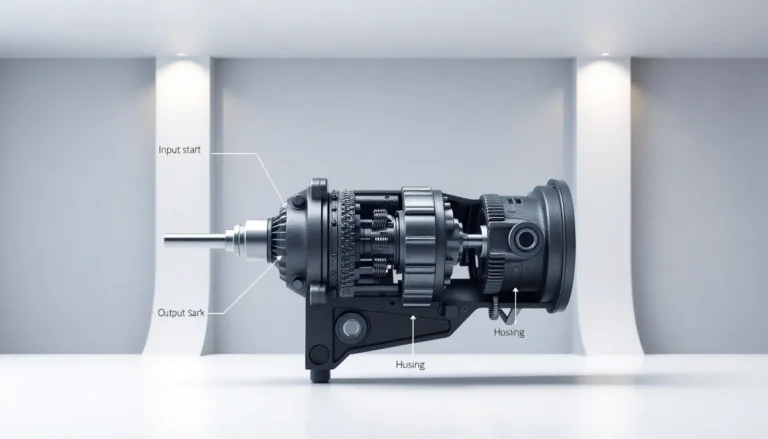Scaling a mountain is no walk in the park—unless that park is filled with steep cliffs, unpredictable weather, and the occasional bear. To conquer those towering peaks, one must arm themselves with the right gear. After all, nothing says “adventure” like realizing halfway up that your backpack is filled with snacks instead of essential tools.
Table of Contents
ToggleOverview of Mountain Summit Gear
Mountain summit gear plays a critical role in successful ascents. Essential categories include clothing, tools, and safety equipment. Climbers need weather-appropriate apparel made from moisture-wicking and breathable fabrics.
Footwear matters significantly during climbs. Sturdy hiking boots provide traction and support. The use of trekking poles enhances stability on uneven terrain.
Safety gear such as helmets, harnesses, and ropes increases protection against falls. Ice axes are vital for climbing icy slopes, while crampons ensure grip on frozen surfaces.
Navigational tools like compasses and GPS devices help maintain route accuracy. First aid kits equip climbers to handle injuries promptly. Hydration packs or water bottles keep individuals hydrated throughout the climb.
Additional comfort items include lightweight sleeping bags and portable stoves for extended trips. Multi-tools can simplify various tasks, reducing the number of separate items carried.
Climbers might consider personal locator beacons for emergency situations. The right gear enhances confidence and performance in challenging conditions. Assembling a comprehensive list ensures preparedness for the unexpected.
Essential Gear for Climbers
Climbers require specific gear to ensure safety and enhance performance during ascents. Essential items include footwear, clothing layers, and backpacks.
Footwear
Proper footwear plays a critical role in climbing. Sturdy hiking boots provide traction and support on rugged terrains. These boots should feature waterproof materials to withstand wet conditions. Trail runners, while lighter, offer flexibility for speed. Custom insoles enhance comfort during long treks. Lastly, specialized climbing shoes maximize grip on rocky surfaces, making them indispensable for technical climbs.
Clothing Layers
Effective clothing layers create a protective barrier against harsh weather. Base layers made from moisture-wicking fabrics keep perspiration away from the skin. Mid-layers, like fleece jackets, provide insulation for colder conditions. Outer layers made from waterproof and wind-resistant materials shield climbers from precipitation and wind chill. Accessories such as gloves and hats help maintain warmth. Prioritizing breathability ensures comfort during intense physical exertion.
Backpack
Selecting the right backpack is essential for carrying gear efficiently. Backpacks should feature adjustable straps and a padded hip belt for comfort. Narrow profiles allow for maneuverability in tight spaces. Storage compartments help organize gear, ensuring easy access. Hydration systems or compartments for water bottles facilitate hydration on the go. Considering weight distribution enhances balance and reduces fatigue on long climbs.
Navigation and Safety Equipment
Climbers must prioritize navigation and safety equipment for a successful mountain ascent. These tools facilitate accurate route finding and enhance overall safety during treks.
GPS Devices
GPS devices provide accurate positioning, helping climbers track their route with precision. Many models offer detailed topographic maps, waypoints, and trip tracking features. Compact and lightweight options are available for easy transport. Some devices also include features like barometric altimeters and weather updates. With proper use, GPS devices can significantly reduce the risk of getting lost in challenging terrain.
First Aid Kits
First aid kits are essential for addressing injuries while climbing. A well-stocked kit should include bandages, antiseptics, pain relievers, and adhesive tape. Additional items like gauze, scissors, and tourniquets increase preparedness for various scenarios. Climbers should customize their kits based on personal needs and expedition length. Regularly inspecting and replenishing supplies ensures that the kit remains effective when emergencies occur.
Climbing Tools and Accessories
Essential tools and accessories enhance climbing safety and efficiency. Climbers rely on specialized equipment to navigate challenging terrains effectively.
Crampons and Ice Axes
Crampons, equipped with metal spikes, provide traction on icy surfaces. These devices attach securely to climbing boots, making steep ascents safer and easier. Ice axes assist climbers in maintaining balance and aid in self-arrest during slips. Choosing correct sizes for both crampons and axes is crucial; oversized equipment can hinder movement while undersized options may fail to grip properly. When climbing on glaciated terrain, combining these tools with proper technique maximizes safety.
Harnesses and Ropes
Harnesses serve as the foundation for safety during climbs. They connect climbers to ropes securely, distributing weight evenly to enhance comfort. Selecting a harness tailored to individual needs ensures optimum fit and performance. Ropes vary in styles; dynamic ropes absorb impact during falls, whereas static ropes are better suited for tasks like rappelling. Regular inspections of harnesses and ropes for wear or damage are critical for safety. Proper care extends the lifespan of this essential gear, promoting a safe climbing environment.
Selecting the Right Gear
Choosing suitable mountain summit gear is crucial for a safe and successful climb. Assessing specific needs based on climbing environments enhances preparation.
Considerations for Different Environments
Different environments demand specialized gear. High-altitude climbs require breathable fabrics to manage moisture effectively. For icy terrains, crampons and ice axes are necessary for stability and traction. In contrast, warm-weather conditions benefit from lightweight and moisture-wicking clothing layers. Weatherproof outerwear becomes essential in unpredictable climates, shielding climbers from rain and wind. Additionally, varying terrain types, such as rocky, steep, or snowy surfaces, necessitate different footwear for adequate support and grip.
Budget-Friendly Options
Affording quality climbing gear doesn’t always require a substantial investment. Many brands offer affordable alternatives that provide essential features without breaking the bank. Prioritizing multi-use items, such as versatile layers or a reliable backpack, optimizes budget expenditures. Discounts on end-of-season gear and second-hand options often yield high-quality equipment at much lower prices. Researching product reviews can also identify budget-friendly gear that doesn’t compromise on safety or functionality. Choosing wisely ensures climbers remain prepared, regardless of their financial limitations.
Equipping oneself with the right mountain summit gear is essential for a successful climbing experience. Each piece of gear plays a crucial role in ensuring safety comfort and performance on the ascent. From weather-appropriate clothing to sturdy footwear and essential safety equipment climbers must prioritize their gear selection based on the specific challenges they’ll face.
Investing time in research and choosing quality items can make all the difference. Whether navigating rugged terrains or unpredictable weather conditions having the right tools enhances confidence and minimizes risks. By assembling a comprehensive gear list climbers can prepare for the unexpected and truly enjoy their mountain adventures.





